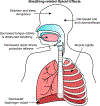Understanding and countering opioid-induced respiratory depression
- PMID: 34089181
- PMCID: PMC8997313
- DOI: 10.1111/bph.15580
Understanding and countering opioid-induced respiratory depression
Abstract
Respiratory depression is the proximal cause of death in opioid overdose, yet the mechanisms underlying this potentially fatal outcome are not well understood. The goal of this review is to provide a comprehensive understanding of the pharmacological mechanisms of opioid-induced respiratory depression, which could lead to improved therapeutic options to counter opioid overdose, as well as other detrimental effects of opioids on breathing. The development of tolerance in the respiratory system is also discussed, as are differences in the degree of respiratory depression caused by various opioid agonists. Finally, potential future therapeutic agents aimed at reversing or avoiding opioid-induced respiratory depression through non-opioid receptor targets are in development and could provide certain advantages over naloxone. By providing an overview of mechanisms and effects of opioids in the respiratory network, this review will benefit future research on countering opioid-induced respiratory depression. LINKED ARTICLES: This article is part of a themed issue on Advances in Opioid Pharmacology at the Time of the Opioid Epidemic. To view the other articles in this section visit http://onlinelibrary.wiley.com/doi/10.1111/bph.v180.7/issuetoc.
Keywords: addiction; brainstem; control of breathing; electrophysiology; mu opioid receptor; opioids; respiratory pharmacology.
© 2021 The British Pharmacological Society.
Conflict of interest statement
Conflict of Interest Statement: Nothing to declare.
Figures



References
-
- Aicher SA, Goldberg A, Sharma S, and Pickel VM (2000). μ‐opioid receptors are present in vagal afferents and their dendritic targets in the medial nucleus tractus solitarius. J Comp Neurol 422: 181–190. - PubMed
Publication types
MeSH terms
Substances
Grants and funding
LinkOut - more resources
Full Text Sources
Other Literature Sources
Medical
Research Materials

